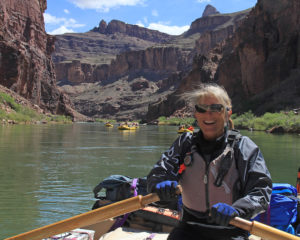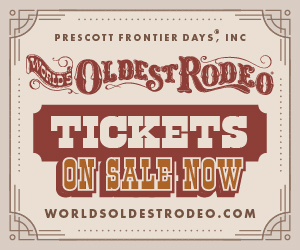 Let’s get one thing straight. Christa Sadler is not that woman in the room in the suit and heels with perfectly manicured nails. “Just don’t make me wear make-up,” she pleaded upon accepting the request to lead the 2020 Flagstaff Festival of Science in the W. L. Gore & Associate’s Keynote Presentation.
Let’s get one thing straight. Christa Sadler is not that woman in the room in the suit and heels with perfectly manicured nails. “Just don’t make me wear make-up,” she pleaded upon accepting the request to lead the 2020 Flagstaff Festival of Science in the W. L. Gore & Associate’s Keynote Presentation.
Sadler is most at home outdoors and happiest running rivers, guiding kayaking excursions, digging in the desert and hiking in the mountains. In her garage, she stores suitcases of fossils and buckets of rocks. These are her treasures. This earth scientist’s resume includes archaeology, geology and paleontology research projects around the world. She has searched for dinosaurs in Montana, fought off dust storms and overly curious camels in the Gobi Desert of Mongolia and steered clear of annoyed marine iguanas in the Galapagos Islands.
For as long as she can remember, Sadler has been playing in the dirt and investigating the world around her. Through her education business, This Earth, she brings students into her world of adventure and exploration. She offers interactive classroom presentations, field trips and lab exercises, and most of all, facilitates discovery.
“I pursue the mission of helping to open the eyes, hearts and minds of students to the extraordinary history and future of our planet and all its creatures,” she said. “I love working with kids around fossils. They have so much fun and I do, too! It’s so interesting to talk about what used to live here. There are several places at the South Rim of the Grand Canyon that have really great fossil exposures. I created a mini field guide, which I give to them, and we mark out an area for them to identify and interpret the fossils.”
Common fossils found at the South Rim are brachiopods, shellfish that are a distant relative of modern-day clams. They lived 270 million years ago when a shallow ocean covered the region. “We talk about what kind of environment these creatures lived in, the depth and temperature of the water, and how they were filter feeders, eating plankton that was just floating along.”
She is a big believer in taking students to the place of discovery. “Kids do a lot better learning about natural sciences when they are outdoors. It makes more sense to everyone, not just kids, to learn ‘in situ,’ to see fossils in place. The pieces get connected more easily in these beautiful locations, and there’s no doubt about it, people have a lot of fun finding their own fossils.”
Sadler grew up mostly in Southern and Northern California. Her mom was a librarian, her dad was a businessman. In fifth grade, a summer school class sparked her interest in science. “We studied the bones of the human body. Also, my mom would take me out to local archaeology digs that were being excavated by the local community college. I’d help out a little bit and that’s when things started to come together for me.”
In addition, she credits her high school biology and physiology teacher for fostering her joy of discovery. “We dissected things and he was so enthusiastic about it all. I was already well on my way to being a digger in the dirt, as I just loved being outside, but he showed us how much fun science can be.”
Nonetheless, Sadler’s grand plan was to become an Olympic sprinter. “I loved going fast and thought I was fast until I got to Berkeley [University of California, Berkeley]. There, I met people who were way faster than I was. In our first college meet, I ran the 100-meter dash and came in dead last.”
At the same time, her passion for archaeology and anthropology continued to develop. She recognized her studies in the field would conflict with workouts on the track. That’s when her attention raced toward a career of sprinting around the globe for science instead of medals.
During her travels, she recognized a lack of emphasis on education for girls. “I realized women were the ones holding their families together and so many had to leave school.”
She started a foundation, One New Education, to help change that. So far, the organization has supported nearly three dozen girls and women in their primary and secondary education goals. On her own dime, Sadler travels to their countries to meet them. “It’s been such a delight, such a joy to get to know these girls. I’ve met maybe half of them.”
Meanwhile, Sadler has written a number of books, including “Life in Stone,” about the fossil history of the Colorado Plateau, “Dawn of the Dinosaurs: The Late Triassic in the American Southwest,” “Where Dinosaurs Roamed: Lost Worlds of Utah’s Grand Staircase” and “The Colorado.”
Sadler earned her bachelor’s degree in physical anthropology and archaeology from the University of California at Berkeley, and her master’s degree in earth sciences from Northern Arizona University. She made Flagstaff her permanent home 34 years ago when she was offered a job at the Museum of Northern Arizona and also as a river guide on the Colorado River.
Whether she’s digging around with scientists such as paleontologist Alan Titus, Ph.D., director of the paleontology lab at Grand Staircase Escalante National Monument, teaching students or providing scholarships for girls in developing countries, this life-long learner encourages the young and young-at-heart to tap into their superpower of curiosity and engage with the world.
To hear from Christa Sadler and find out how to participate in the adventure of scientific discovery, view the W. L. Gore Keynote Presentation: “Tapping into the Superpowers of Science,” at the Flagstaff Festival of Science website, SciFest.org, 7 p.m., Friday, Sept. 18. Sadler will be available for a live, remote question-and-answer session following the presentation.
Favorite meal: Anything I’m eating outdoors! I create my own menu on the river. Red or green curry is easy to prepare.
Guilty pleasure: I love chocolate. Sweets are definitely my biggest weakness. I also love the music of ABBA.
Last moment of gratitude: I just received WhatsApp videos from three of my girls in Nepal. I was so grateful to see these beautiful girls working hard and really trying. They are all studying remotely now. I am so grateful to be able to help them and grateful to those who have donated to One New Education.
Best advice: Keep your mouth shut and your eyes and ears open. Professional and personally, I’ve received and given this advice. It works for everything.
Last time I was starstruck:
About 15 years ago, I was giving a talk at the Western National Parks Association office in Tucson. This woman in the back of the room looked so familiar to me. Afterward, she and her friends came up to introduce themselves. One of her friends said, “Do you know Joan Baez?” I actually started crying. FBN
By Bonnie Stevens, FBN







